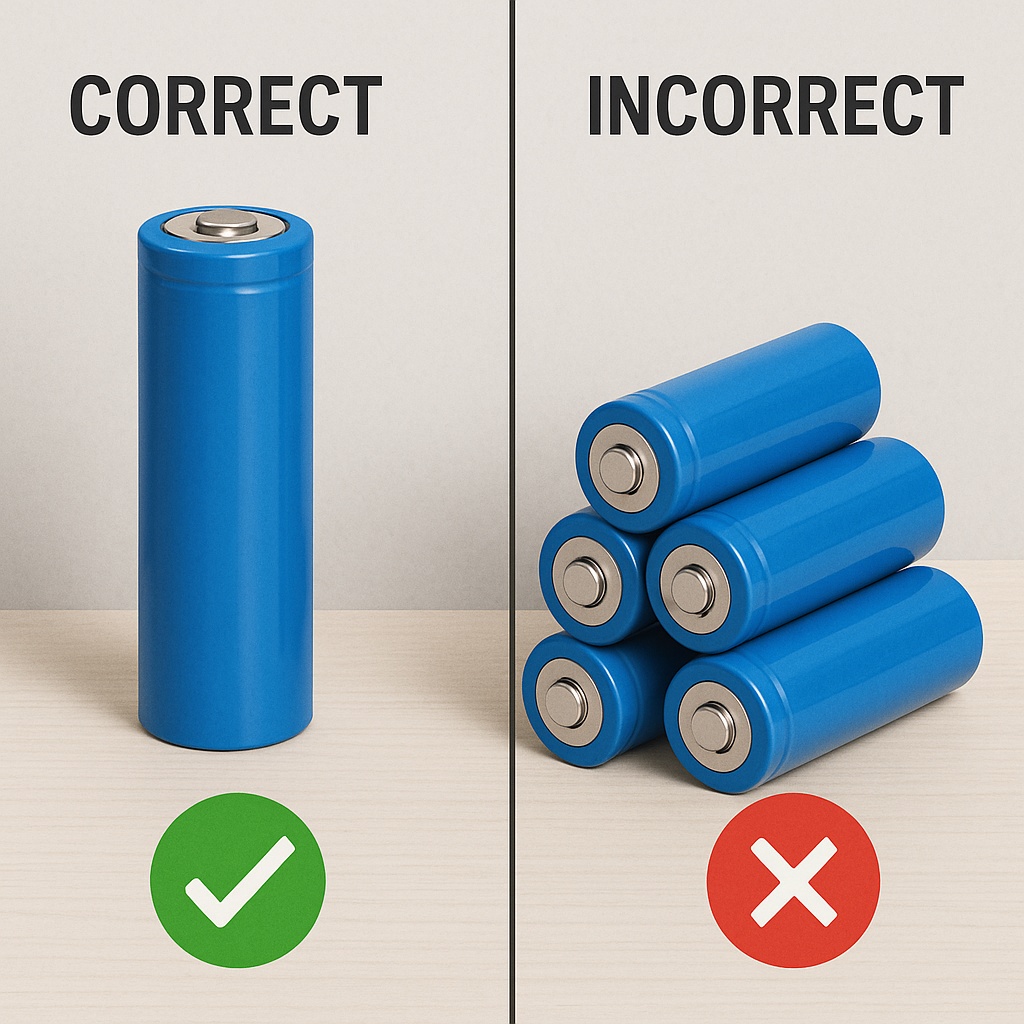နိဒါန်း
လစ်သီယမ်-အိုင်းယွန်းဘက်ထရီများကို စမတ်ဖုန်းများနှင့် ပါဝါကိရိယာများမှ လျှပ်စစ်ကားများနှင့် ဆိုလာစနစ်များအထိ အရာအားလုံးတွင် တွင်ကျယ်စွာအသုံးပြုကြသည်။ သို့သော်လည်း မသင့်လျော်သော သိုလှောင်မှုသည် ၎င်းတို့၏ သက်တမ်းကို တိုစေသည်၊ စွမ်းဆောင်ရည်ကို လျှော့ချနိုင်သည်၊ သို့မဟုတ် လုံခြုံရေးဆိုင်ရာ အန္တရာယ်များကိုပင် ဖြစ်စေနိုင်သည်။ ဘက္ထရီအပိုတွေကို သိမ်းဆည်းတာပဲဖြစ်ဖြစ်၊ စက်ကို ရေရှည်သိုလှောင်မှုမှာပဲဖြစ်ဖြစ်၊ လစ်သီယမ်ဘက်ထရီသိုလှောင်မှုအတွက် အကောင်းဆုံးအလေ့အကျင့်တွေကို နားလည်တာက ဘေးကင်းပြီး အသက်ရှည်ဖို့အတွက် အဓိကသော့ချက်ပါပဲ။ ဒါကတော့ မင်းရဲ့လမ်းညွှန်ချက်အပြည့်အစုံပါ။
သင့်အိမ်တွင် Lithium-Ion ဘက်ထရီများကို မည်သို့သိမ်းဆည်းမည်နည်း။
လီသီယမ်-အိုင်းယွန်းဘက်ထရီများကို နေရောင်ခြည်တိုက်ရိုက်၊ အစိုဓာတ်နှင့် မီးလောင်လွယ်သောပစ္စည်းများနှင့် ဝေးဝေး အေးပြီးခြောက်သွေ့သောနေရာတွင် သိမ်းဆည်းပါ။ အံဆွဲ သို့မဟုတ် ဗီဒိုကဲ့သို့ သင့်အိမ်အတွင်းရှိ အပူချိန်ထိန်းအခန်းသည် အကောင်းဆုံးဖြစ်သည်။ ပြတင်းပေါက်များ၊ ရေတိုင်ကီများအနီး သို့မဟုတ် အပူရှိန်ထုတ်ပေးသည့် ကိရိယာများဘေးတွင် အပူချိန်လွန်ကဲစွာ ခံစားရနိုင်သည့်နေရာများကို ရှောင်ကြဉ်ပါ။
လီသီယမ်ဘက်ထရီများကို ကားဂိုဒေါင်တွင် သိမ်းဆည်းရန် ဘေးကင်းပါသလား။
သင့်ရာသီဥတုပေါ်မူတည်သည်။ ကားဂိုဒေါင်များသည် လစ်သီယမ်ဘက်ထရီများကို သိုလှောင်ရန် အန္တရာယ်များသောနေရာများဖြစ်စေနိုင်သည့် အပူချိန်ထိန်းညှိမှုကင်းမဲ့နေတတ်သည်။ သာယာပြီး တည်ငြိမ်သော ရာသီဥတုရှိသော နေရာများတွင် ကားဂိုဒေါင်ကို လက်ခံနိုင်သည်။ သို့သော်လည်း သင့်ကားဂိုဒေါင်သည် နွေရာသီ သို့မဟုတ် ဆောင်းရာသီတွင် အလွန်ပူပြင်းပါက၊ အပူချိန် 15°C မှ 25°C (59°F–77°F) အတွင်းတွင် ဘက်ထရီများကျန်ရှိနေသော အိမ်တွင်းဘက်ထရီများကို သိမ်းဆည်းခြင်းက ပိုကောင်းပါသည်။
အသုံးမပြုသည့်အခါ လစ်သီယမ်ဘက်ထရီများကို သင်မည်သို့သိမ်းဆည်းမည်နည်း။
အသုံးမပြုသော လစ်သီယမ်-အိုင်းယွန်းဘက်ထရီများကို သိမ်းဆည်းသောအခါ-
-
ပမာဏ 50% မှ 60% အထိ အားသွင်းပါ။သိမ်းဆည်းခြင်းမပြုမီ။
-
အဆက်ဖြတ်ပါ။၎င်းတို့ကို စက်များ သို့မဟုတ် အားသွင်းကိရိယာများမှ
-
သူတို့ကို နေရာချပါ။သတ္တုမဟုတ်သော ကွန်တိန်နာများဝါယာရှော့မဖြစ်စေရန် သို့မဟုတ် မူရင်းထုပ်ပိုးမှု။
-
သူတို့ကိုဝေးဝေးထားပါ။မီးလောင်လွယ်သောပစ္စည်းများ.
Lithium ဘက်ထရီများကို အသုံးမပြုဘဲ မည်မျှကြာအောင် သိမ်းဆည်းနိုင်မည်နည်း။
လစ်သီယမ်-အိုင်းယွန်းဘက်ထရီအများစုကို ဘေးကင်းစွာ သိမ်းဆည်းထားနိုင်သည်။၆ လမှ ၁၂ လမှန်ကန်စွာ သိမ်းဆည်းထားလျှင် သိသိသာသာ ပျက်စီးခြင်းမရှိဘဲ။ သို့သော်၊ အကောင်းဆုံးကျန်းမာရေးကိုထိန်းသိမ်းထားရန် 3-6 လတစ်ကြိမ် ဗို့အားကိုစစ်ဆေးပြီး 50-60% သို့ အားပြန်သွင်းရန် အကြံပြုလိုပါသည်။
အသုံးမပြုသည့်အခါ လစ်သီယမ်ဘက်ထရီများကို မည်မျှအားသွင်းသင့်သနည်း။
လအနည်းငယ်ကြာတိုင်း သင့်ဘက်ထရီ၏ဗို့အားကို စစ်ဆေးပါ။ ဆဲလ်တစ်ခုလျှင် 3.6V အောက်ကျသွားပါက၊ ၎င်းကို 50-60% ခန့်အထိ အားပြန်သွင်းပါ။ ဗို့အား 3.0V အောက်တွင် ကျဆင်းသွားစေရန် ရှောင်ကြဉ်ပါ၊ အဘယ်ကြောင့်ဆိုသော် ၎င်းသည် နက်ရှိုင်းသော ထုတ်လွှတ်မှုနှင့် ဆဲလ်ကို အပြီးတိုင် ပျက်စီးစေနိုင်သည်။
Lithium ဘက်ထရီများကို မှန်ကန်စွာ သိမ်းဆည်းရန် လိုအပ်ပါသလား။
လီသီယမ်ဘက်ထရီများကို မတ်မတ်သိမ်းဆည်းခြင်းသည် တင်းကြပ်စွာမလိုအပ်သော်လည်း ၎င်းသည် အလေ့အကျင့်ကောင်းတစ်ခုဖြစ်သည်။ မှန်ကန်သောသိုလှောင်မှုသည် terminals များပေါ်ရှိ ဖိအားကို လျော့နည်းစေပြီး ပျက်စီးနိုင်ခြေကို လျှော့ချပေးသည်။ ရနိုင်လျှင် ထုတ်လုပ်သူ၏ လမ်းညွှန်ချက်များကို အမြဲလိုက်နာပါ။
 Lithium ဘက်ထရီများကို တစ်ခုနှင့်တစ်ခုအပေါ်တွင် သိမ်းဆည်းနိုင်ပါသလား။
Lithium ဘက်ထရီများကို တစ်ခုနှင့်တစ်ခုအပေါ်တွင် သိမ်းဆည်းနိုင်ပါသလား။
လစ်သီယမ်-အိုင်းယွန်းဘက်ထရီများကို တစ်ခုနှင့်တစ်ခုအပေါ်တွင် တိုက်ရိုက်ထည့်ခြင်းမှ ရှောင်ကြဉ်ပါ။ ပွတ်တိုက်မှု သို့မဟုတ် ဖိအားများသည် ပိုက် သို့မဟုတ် တာမီနယ်များကို ပျက်စီးစေပြီး မီးအန္တရာယ်ကို တိုးစေသည်။ ယင်းအစား ရွေ့လျားမှုကို တားဆီးရန် ၎င်းတို့ကို အကွက်များ သို့မဟုတ် အပိုင်းပိုင်းများဖြင့် ဘေးချင်းကပ် သိမ်းဆည်းပါ။
လစ်သီယမ်-အိုင်းယွန်းဘက်ထရီတွေကို အားသွင်းထားရင် သိမ်းဆည်းထားရင် ပိုကောင်းမှာလား။
တစိတ်တပိုင်း ကောက်ခံတယ်။အထူးသဖြင့် အနီးပတ်ဝန်းကျင်တွင် အကောင်းဆုံးဖြစ်သည်။50% မှ 60% စွမ်းရည်. အားအပြည့်သွင်းထားသည့်ဘက်ထရီများသည် ပိုမိုမြန်ဆန်စွာကျဆင်းနိုင်ပြီး အားအပြည့်သွင်းထားသည့်ဘက်ထရီများသည် နက်ရှိုင်းသောအထွက်ပေါက်သို့ကျသွားနိုင်ပြီး အားပြန်မသွင်းနိုင်ပါ။ ဤလက်ကျန်သည် သိုလှောင်မှုအတွင်း ဓာတုဗေဒတည်ငြိမ်မှုကို ထိန်းသိမ်းရန် ကူညီပေးသည်။
ဆောင်းရာသီ အိမ်တွင်းမှာ Lithium ဘက်ထရီတွေကို ဘယ်လို သိမ်းဆည်းမလဲ။
ဆောင်းရာသီတွင် သိုလှောင်မှုတစ်ခုတွင် နေရာယူသင့်သည်။ခြောက်သွေ့၊ အိမ်တွင်းပတ်ဝန်းကျင်၎င်းသည် အေးခဲနေသော (0°C/32°F) အထက်တွင် ရှိနေသည်။ ဘက်ထရီအိုးများကို အပူမထားသော တဲများ သို့မဟုတ် ကားဂိုဒေါင်များတွင် သိမ်းဆည်းခြင်း ရှောင်ကြဉ်ပါ။ စိုစွတ်မှုစိုးရိမ်ရပါက ဆီလီကာဂျယ်အထုပ်များပါသော လေလုံသောဘူးများကို အသုံးပြုပါ။ သိုလှောင်မှုမပြုမီ၊ ဘက်ထရီ 50-60% ဝန်းကျင်အား အားသွင်းထားကြောင်း သေချာပါစေ။
နိဂုံး
သင့်လျော်သော လီသီယမ်-အိုင်းယွန်းဘက်ထရီ သိုလှောင်မှုသည် မရှုပ်ထွေးသော်လည်း ဘေးကင်းမှုနှင့် ရေရှည်စွမ်းဆောင်ရည်အတွက် မရှိမဖြစ်လိုအပ်ပါသည်။ ၎င်းတို့ကို အေးအောင်၊ ခြောက်သွေ့စေပြီး တစ်စိတ်တစ်ပိုင်းအားသွင်းထားပါ။ အလွန်အမင်း အပူချိန်ကို ရှောင်ပြီး အသုံးမပြုဘဲ အကြာကြီး ထိုင်မနေပါနဲ့။ ဤရိုးရှင်းသောလမ်းညွှန်ချက်များကို လိုက်နာခြင်းဖြင့်၊ သင်သည် သင်၏ဘက်ထရီများ၏ သက်တမ်းကို တိုးမြှင့်နိုင်ပြီး မတော်တဆမှု သို့မဟုတ် ပျက်စီးမှုအန္တရာယ်ကို လျှော့ချနိုင်သည်။
စာတိုက်အချိန်- မေလ-၀၈-၂၀၂၅
